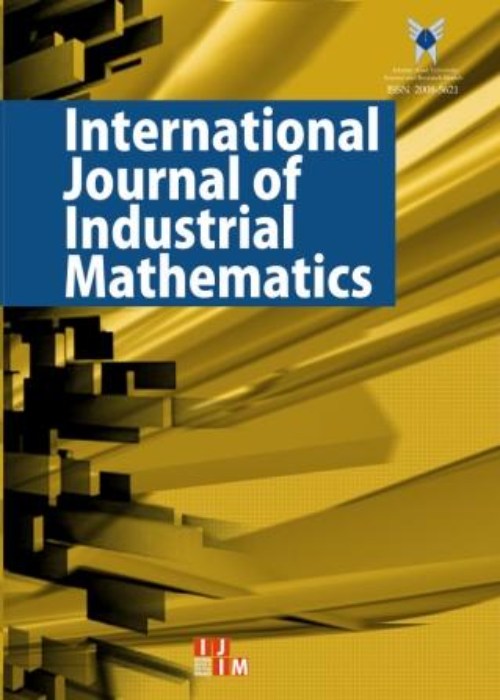فهرست مطالب
International Journal of Industrial Mathematics
Volume:10 Issue: 3, Summer 2018
- تاریخ انتشار: 1397/05/01
- تعداد عناوین: 8
-
-
Pages 229-236In this work, we first reformulate the unsteady flow of gas through a porous medium problem in [0,+∞) to a problem in [-1,1] by variable transformation μ = (x-s)/(x+s), and using spectral collocation method based on Chebyshev polynomials to approximate the resulting problem. The comparison of the results obtained by this method with results obtained by other methods shows that this method provides more accurate and numerically stable solutions.Keywords: Chebyshev pseudo-spectral method, Newton iteration method, Positive scaling factor, Chebyshev interpolation
-
Pages 237-244In this paper using DEA technique, four-stage DEA model mooted in order to consider the situation in which returned products exist. Returned products are the inputs of the previous sub-processes that need to be reprocessed due to existence of flaws. Here, a supply chain with four stages as supplier, manufacture, distributor, and retailer with intermediate and return products has been considered and a DEA model formulated for performance analysis.Keywords: Supply Chain, data envelopment analysis, Multi-component Decision making unit, returned products, efficiency
-
Pages 245-246In \cite{beh}, the authors claimed by a counterexample that the cross product definition in \cite{molo} is not correct and thus the proposed technique is false. In this note, we show that this assertion is incorrect.Keywords: Cross product, Fully fuzzy linear system, Fuzzy approximate solution
-
Pages 247-258With a brief review of the studies on the industry in Data Envelopment Analysis (DEA) framework, the present paper proposes inner and outer technologies when only some basic information is available about the technology. Furthermore, applying Linear Programming techniques, it also determines lower and upper bounds for directional distance function (DDF) measure, overall and allocative efficiency in industry level. Finally, the results are illustrated using a Cobb-Douglas function.Keywords: Data Envelopment Analysis (DEA), Industry, Unknown technology, Ufficiency bound
-
Pages 261-269This study aims to discuss the use of robustness analysis in evaluation and selection the strategies of an organization based on a matrix approach. The proposed technique can overcome the weakness of the robustness analysis model related to reviewing a few future scenarios and also, make it possible to in a short time include the ideas of the decision makers who participate in the strategic planning process. ...Keywords: Soft operational research, Strategic programming, Robustness analysis, Matrix data, Performance profile
-
Pages 270-277In this paper, a procedure is reported that discuss how linear algebra can be used in image compression. The basic idea is that each image can be represented as a matrix. We apply linear algebra (QR factorization and wavelet transformation algorithms) on this matrix and get a reduced matrix out such that the image corresponding to this reduced matrix requires much less storage space than the original image.Keywords: Image compression, Wavelets, Matrix factorization, PSNR
-
Pages 279-297Connectivity in WSNs is vital to preserve the network performance. Reported algorithms try to restore connectivity by appropriately selecting the failure handler. This paper, initially presents a hybrid algorithm based on distributed learning automata named DLA-BuS for critical node backup selection. Then, we present DLA-MRF to repair stimulant failure of two adjacent actors. Simulations using Castalia demonstrate that proposed algorithms outperform representative methods in terms of some well-known performance parameters.Keywords: Wireless sensor, actor networks, Fault recovery, Connectivity restoration, Node relocation, distributed learning automata
-
Pages 299-314"> The aim of the present research is to analyze, comparatively, the content of mathematics textbooks in the first grade used in Iran, Japan, and the United States, which has three analytic axes, namely: teaching and learning opportunities based on process and content standards of NCTM, assessment and practice opportunities and content treatment according to five grade coding (narrative expressions, mathematical expressions, pictures, shapes, tables and diagrams). The statistical population of this query was the content of mathematics textbooks in the first grade used in Iran (both old version and the recent one), Japan, and the United States (California State). This research was conducted based on comparative content analysis method in which qualitative and quantitative analyses were used for data collection and data analysis, respectively. The results showed that in all content standards, except for measurement standard and statistics, the percentage of standards in the recent version of textbook used in Iran have been reduced practice standards, the recent version of math textbook used in Iran showed a significant increase in the treatment of connection standard as compared to that of its old version. According to the research findings, reasoning and proof standard was not treated in Japanes textbook as well as in the old and recent versions of textbooks used in Iran. Analysis of exercise and evaluation opportunities in the recent version of the Iranian textbook revealed that there was not any use of true-false questions. Therefore, the researcher’s recommendations based on their findings are: 1) more emphasis on using numeric and algebraic expressions in the treatment of concepts; 2) increasing, significantly, the treatment of reasoning and proof standard; 3) using truefalse questions in exercises and 4) using natural images in conceptualizations and transferring cultural contents.Keywords: Teaching mathematics, Learning, teaching opportunities, Evaluation, First grade, textbook


